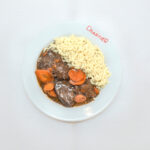Researchers have documented the first enteroinvasive E. coli outbreak in Thailand. An enteroinvasive E. coli (EIEC) outbreak affecting 154 people was identified among attendees at a wedding in Loei Province. The median time to symptom onset was 18 hours and ranged from seven to 72 hours. The epidemiological evidence suggested… Continue Reading Foodborne Illness Investigations, Foodborne Illness Outbreaks, World, 2023 outbreaks, enteroinvasive E. coli (EIEC), European Journal of Clinical Microbiology and Infectious Diseases, ground beef, Thailand, wedding food safety Food Safety News
Researchers have documented the first enteroinvasive E. coli outbreak in Thailand.
An enteroinvasive E. coli (EIEC) outbreak affecting 154 people was identified among attendees at a wedding in Loei Province. The median time to symptom onset was 18 hours and ranged from seven to 72 hours. The epidemiological evidence suggested that larb-neua-dib, a spicy ground raw beef salad, was the probable source.
According to the study published in the European Journal of Clinical Microbiology and Infectious Diseases, EIEC outbreaks are underreported because of challenges with identification.
The alert was raised when a group of people who attended a rural wedding in March 2023 went to a hospital in northeast Thailand with gastroenteritis.
Initial parasite hypothesis
Initially, 52 cases were identified, of which 14 were admitted to hospital and 38 were in the community. Standard culture methods did not identify a bacterial pathogen. However, 13 of 18 stool specimens showed an Entamoeba histolytica morphology based on microscopy, leading to the initial suspicion that this was the cause of the outbreak.
The Joint Investigation Team from the Loei Provincial Health Office and the Surveillance and Rapid Response Team in Na Duang District conducted an outbreak investigation. Approximately 500 individuals had attended the wedding, of whom 272 were traced.
Of people traced, 154 met the case definition, three others were unwell, and the remaining 115 were asymptomatic. In March, stool specimens were collected from 59 people who met the case definition and four asymptomatic attendees.
EIEC and Shigella are closely related bacterial species. Testing detected Shigella or EIEC (ipaH gene) in the first six specimens, but no parasites, including Entamoeba histolytica, or viruses were found.
Initial microscopy at the site revealed the presence of cysts in stools with Entamoeba histolytica-like morphology. However, later genetic testing was negative, suggesting cysts may have been E. dispar, a similar but non-pathogenic species. EIEC was isolated from nine of 17 stool specimens.
Origin of EIEC unknown
The wedding meal had been prepared and served on March 10 to staff, including the cooks. The main dish was beef from cattle owned by the wedding host that had been butchered on the evening of March 9. The wedding meal was served to guests on March 11.
Clinical data were available for 45 patients who tested positive for ipaH. The first two cases were women, aged 48 and 71, and one was a cook. They consumed larb-neua-dib on March 10. By March 12, 11 cooks reported symptoms and 10 tested positive for ipaH.
Of the 45 patients, 44 had consumed larb-neua-dib. A total of 24 cases were male and they ranged in age from 5 to 75 years old. The most common symptoms were watery stools and abdominal pain. Other reported symptoms included fever, loose stools, headache, fatigue, vomiting, and nausea.
Leftover raw beef and larb-neua-dib from the wedding was tested. Salmonella and E. coli were isolated from the raw beef sample, and E. coli from the larb-neua-dib.
Whole genome sequencing revealed that EIEC isolates were serotype O8:H19 sequence type 4267.
“The epidemiological evidence suggests that larb-neua-dib was the probable source. However, it is unclear whether the EIEC was present in the beef cattle or whether the beef was contaminated by human handling or from other sources, such as water,” said scientists.
(To sign up for a free subscription to Food Safety News, click here.)









